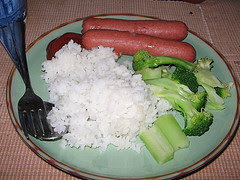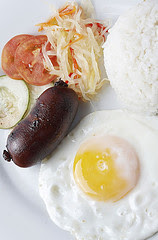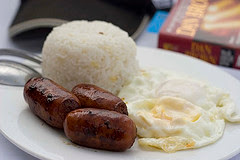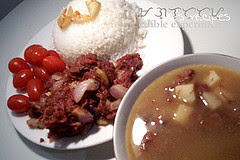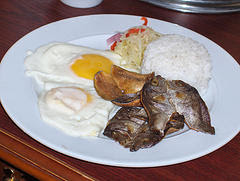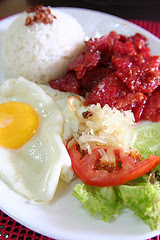Hay naku! After a couple of months ngayun lang nagparamdam itong mga friends ko sa CDO. Whatever. They told me na meron na daw bagong tambayan ng mga yuppies and gwapito conio boys sa Cagayan de Oro. Cafe Ganadores daw ang pangalan.
I just got off the phone with Cagayan de Oro's hunkiest hunk Jeremy - ay! meron bang ganung term? - o sige whatever ulit. Yeah, naka-usap ko sya and he's inviting me to go and try this new coffee shop along Vamenta Boulevard in Carmen. Wait nga pala...did he just invited me for a date? OMG! Yes! Yes! Yes!
Teka nga, wait lang...pupuntahan ko tlaga yang Cafe Ganadores na yan one of these days, with or without Jeremy, kasi nga maraming cute doon. Sabi rin ni Oroboy, masarap yung coffee dun so, let's try and see. Okey? I'll blog about their coffee, wait for my review.
So to all my readers in Cagayan de Oro, try this new coffee shop. If the conio boys say it's good...then it must be good, di ba?
I'll see you there girls! Mwah! Smack, smack!
Monday, August 27, 2007
Saturday, July 7, 2007
MERIENDA (SNACKS) RECIPE
This covers a peculiarly Philippine meal — the snack or merienda which, while roughly corresponding to the American coffee break or English tea, is really rather different.
At merienda time, usually four in the afternoon and sometimes also around ten in the morning, the average Filipino takes his traditional snack. Foods served at merienda can be almost anything.
Usually, they include noodles, salads, some types of soup like arroz caldo, bachoy and pancit molo, some meat dishes, like rhenudo, served with pan de sal and dinuguan served with puto, and almost all kinds of desserts. And of course, tea, coffee or soft drinks.The typical merienda fares, however, are native delicacies made from glutinous rice and coconut. Included in this section are some of the more popular rice cakes (bibingka).
Bibingka Cassava

Ingredients
* 1 kilo cassava roots or kamoteng kahoy (grated)* 4 cups coconut cream* 2 cups white sugar* ¼ cup melted butter or margarine* 2 whole eggs* dash of eggs yellow food coloring(optional)* topping
METHOD
Beat eggs slightly. Add to all ingredients. Mix well until well blended.Pour into a grease pan, lined with banana leaves (greased). Bake a preheated oven at 340 for 20 minutes. Pour topping on top, continue baking for 15 minutes or until topping golden brown.
Toppings.
* 1 can (big) condensed milk* 1 cup thin coconut cream* 2 tbsp. Flour
Dissolve flour in ¼ cup of the coconut cream before blending with condensed milk and the rest of the coconut milk. Cook in medium heat stirring constantly until it thickens.
Cuchinta

Ingredients
* 1 cup all-purpose flour* 2 cups water* 1 tsp. lija* 1 cup brown sugar (packed)* red food coloring
METHOD
Add water to flour gradually while beating. Then mix in the remaining ingredients, plus a dash of red food coloring. Continue beating until well blended. Pour on ungreased molders (3/4 full). Cover with cheese cloth and steam for 30 minutes or until done. Serve with fresh grated coconut.Note: Boil water in steamer before placing molds.
Thursday, July 5, 2007
Pinoy Cooking Methods
The Tagalog words for popular cooking methods are listed below:
"Inadobo" - cooked in soy sauce, vinegar and garlic
"Guisado" - sauteed with garlic, onions and tomatoes
"Prito" - fried or deep fried
"Inihaw" - grilled over charcoals
"Nilaga" - boiled, sometimes with onions and black peppers
"Kinilaw" or "Kilawin" - cubes of raw fish pickled in a marinade of vinegar and/or kalamansi juice, usually along with garlic, onions, ginger, tomato, and/or hot/sweet peppers
"Sinigang" - boiled with a tamarind base
"Pinaksiw" - cooked in vinegar and ginger or just add "all-purpose" sauce
"Ginataan" - cooked with coconut milk
"Inadobo" - cooked in soy sauce, vinegar and garlic
"Guisado" - sauteed with garlic, onions and tomatoes
"Prito" - fried or deep fried
"Inihaw" - grilled over charcoals
"Nilaga" - boiled, sometimes with onions and black peppers
"Kinilaw" or "Kilawin" - cubes of raw fish pickled in a marinade of vinegar and/or kalamansi juice, usually along with garlic, onions, ginger, tomato, and/or hot/sweet peppers
"Sinigang" - boiled with a tamarind base
"Pinaksiw" - cooked in vinegar and ginger or just add "all-purpose" sauce
"Ginataan" - cooked with coconut milk
Wednesday, July 4, 2007
Monday, July 2, 2007
Pinoy Breakfast
Traditional breakfast usually includes the following:
Pan de sal - is derived from Spanish words for "bread of salt". Contrary to its name, it contains relatively little salt is a sweet bread roll which can be spread with butter, jam, marmalade, peanut butter or kesong puti.
Kesong puti - is a soft fresh cheese made from carabao's milk.
Champorado - is a type of rice porridge flavored with chocolate. It is not to be confused with Mexican champurrado which is a hot chocolate drink.
Sinangag - is fried garlic rice, served with a choice or two from other meat dishes.
Tapa - is local beef jerky, served with fried eggs and sinangag.
Longganisa - is a local chorizo or sausage, served with fried eggs and sinangag.
Tocino - is sweetened meat, served with fried eggs and sinangag.
Daing na Bangus - means salted and dried milkfish. It is often served with sinangag and fried eggs as well as sliced tomatoes, vinegar or achara.
Itlog na Pula - are salted duck eggs usually served with tomatoes, onions, and sinangag.
Kape barako - is strong brewed coffee from the mountains of Batangas.
Silogs - are meat as a main ingredient to be served with sinangág (fried rice) and itlog (egg).
The three most commonly seen silogs are
tapsilog having tapa as the meat ingredient;
tocilog having tocino as the meat ingredient;
longsilog having longganisa as a meat ingredient.
Other silogs are sometimes seen, including
hotsilog, with a hot dog;
bangsilog, with bangus (milkfish);
dangsilog, with danggit (rabbitfish);
spamsilog, with spam;
adosilog, with adobo;
chosilog, with chorizo;
chiksilog, with chicken;
cornsilog, with canned corned beef;
litsilog, with lechon.
Pan de sal - is derived from Spanish words for "bread of salt". Contrary to its name, it contains relatively little salt is a sweet bread roll which can be spread with butter, jam, marmalade, peanut butter or kesong puti.
Kesong puti - is a soft fresh cheese made from carabao's milk.
Champorado - is a type of rice porridge flavored with chocolate. It is not to be confused with Mexican champurrado which is a hot chocolate drink.
Sinangag - is fried garlic rice, served with a choice or two from other meat dishes.
Tapa - is local beef jerky, served with fried eggs and sinangag.
Longganisa - is a local chorizo or sausage, served with fried eggs and sinangag.
Tocino - is sweetened meat, served with fried eggs and sinangag.
Daing na Bangus - means salted and dried milkfish. It is often served with sinangag and fried eggs as well as sliced tomatoes, vinegar or achara.
Itlog na Pula - are salted duck eggs usually served with tomatoes, onions, and sinangag.
Kape barako - is strong brewed coffee from the mountains of Batangas.
Silogs - are meat as a main ingredient to be served with sinangág (fried rice) and itlog (egg).
The three most commonly seen silogs are
tapsilog having tapa as the meat ingredient;
tocilog having tocino as the meat ingredient;
longsilog having longganisa as a meat ingredient.
Other silogs are sometimes seen, including
hotsilog, with a hot dog;
bangsilog, with bangus (milkfish);
dangsilog, with danggit (rabbitfish);
spamsilog, with spam;
adosilog, with adobo;
chosilog, with chorizo;
chiksilog, with chicken;
cornsilog, with canned corned beef;
litsilog, with lechon.
Sunday, July 1, 2007
History of Pinoy Cooking and Influences
Malays during the pre-Hispanic era in the Philippines prepared food by boiling, steaming, or roasting. This ranged from the usual livestock such as carabao (water buffaloes), cows(?), chickens and pigs to seafood from different kinds of fish, shrimps, prawns, crustaceans and shellfish. There are a few places in the country where the broad range in their diet extended to monitor lizards, dogs and locusts. Malays have been cultivating rice, an Asian staple since 3200 B.C.[1]. Pre-Hispanic trade with China, India, the Middle-East and the rest of Southeast Asia introduced a number of staples into Filipino cuisine most notably toyo (soy sauce) and patis (fish sauce), as well as the method of stir-frying and making savory soup bases.
The arrival of Spanish settlers brought with them chili peppers, tomato sauces, corn and method of sauteeing with garlic and onions called guisado finding their way into Philippine cuisine. They also braised food with vinegar and spices to preserve the food due to no refrigeration. They had a variety of sources in their diet. Local adaptations of Spanish dishes then became common such as paella into its Pilipino version of arroz valenciana, Chorizo into its local version of Longganisa, escabeche and adobo [this is connected to the Spanish dish adobado] remain popular to this day.
During the nineteenth century, Chinese food became a staple of the panciterias or noodle shops around the country, although they were marketed with Spanish names. "Comida China" (Chinese food) includes arroz caldo (rice and chicken gruel) and morisqueta tostada (an obsolete term for sinangag or fried rice).
Since 1900 when American colonial rule began, Philippine cuisine has been influenced by American, French, Italian, and Japanese cuisines and culinary procedures.[2] Today, Philippine cuisine continues to evolve as new techniques and styles of cooking finds their way into one of the most active melting pots of Asia.
The arrival of Spanish settlers brought with them chili peppers, tomato sauces, corn and method of sauteeing with garlic and onions called guisado finding their way into Philippine cuisine. They also braised food with vinegar and spices to preserve the food due to no refrigeration. They had a variety of sources in their diet. Local adaptations of Spanish dishes then became common such as paella into its Pilipino version of arroz valenciana, Chorizo into its local version of Longganisa, escabeche and adobo [this is connected to the Spanish dish adobado] remain popular to this day.
During the nineteenth century, Chinese food became a staple of the panciterias or noodle shops around the country, although they were marketed with Spanish names. "Comida China" (Chinese food) includes arroz caldo (rice and chicken gruel) and morisqueta tostada (an obsolete term for sinangag or fried rice).
Since 1900 when American colonial rule began, Philippine cuisine has been influenced by American, French, Italian, and Japanese cuisines and culinary procedures.[2] Today, Philippine cuisine continues to evolve as new techniques and styles of cooking finds their way into one of the most active melting pots of Asia.
Friday, June 29, 2007
Pinoy Regional Specialties
The Philippine islands are home to various ethnic groups resulting in varied regional cuisine.
Ilocanos from the rugged Ilocos region boast of a diet heavy in boiled or steamed vegetables and freshwater fish, but they are particularly fond of dishes flavored with bagoong, fermented fish that is often used instead of salt. Ilocanos often season boiled vegetables with bagoong monamon (fermented anchovy paste) to produce pinakbet. Local specialties include the soft white larvae of ants and "jumping salad" of tiny live shrimp.
The Igorots prefer roasted meats, particularly carabao's meat, goat's meat, and venison.
Pampanga is the culinary center of the Philippines. Among the treats produced in Pampanga are longganisa (original sweet and spicy sausages), kalderetang kambing (savory goat stew), and tocino (sweetened-cured pork). Kapampangan cuisine makes use of every regional produce available to the native cook, combining pork cheeks and offal to make sisig. Kare-kare is also known to have been originated from Pampanga.
Bulacan is popular for chicharon (pork rinds) and pastries like puto, kutsinta, and many more...
Cainta in Rizal, province east of Manila, is known for its Filipino rice cakes and puddings.
Laguna is known for buko pie (coconut pie) and panutsa (molasses clustered peanuts).
Batangas is home to Taal Lake, a body of water that surrounds Taal Volcano. The lake is home to 75 species of freshwater fish. And of these, the maliputo and tawilis are two of the world's rarest. Maliputos and tawilises are delicious native delicacies. Batangas is also known for its special coffee, kapeng barako.
Iloilo is popular for La Paz batchoy, pancit molo, dinuguan, puto, and biskotso.[citation needed]
Cebu is popular for lechón, sweets (like dried mangoes), mango, and caramel tarts.
Further south, dishes are filled with the scents of Southeast Asia: coconut milk, turmeric, coriander, lemon grass, ginger, and chilies — an ingredient not present in other regional cuisine (except in the Bicol Region whose use of chilies is more liberal compared to others). Since southern regions are predominantly Islamic, pork dishes are hardly present. Popular crops such as cassava root, sweet potatoes (kamote), and yams are grown.
Ilocanos from the rugged Ilocos region boast of a diet heavy in boiled or steamed vegetables and freshwater fish, but they are particularly fond of dishes flavored with bagoong, fermented fish that is often used instead of salt. Ilocanos often season boiled vegetables with bagoong monamon (fermented anchovy paste) to produce pinakbet. Local specialties include the soft white larvae of ants and "jumping salad" of tiny live shrimp.
The Igorots prefer roasted meats, particularly carabao's meat, goat's meat, and venison.
Pampanga is the culinary center of the Philippines. Among the treats produced in Pampanga are longganisa (original sweet and spicy sausages), kalderetang kambing (savory goat stew), and tocino (sweetened-cured pork). Kapampangan cuisine makes use of every regional produce available to the native cook, combining pork cheeks and offal to make sisig. Kare-kare is also known to have been originated from Pampanga.
Bulacan is popular for chicharon (pork rinds) and pastries like puto, kutsinta, and many more...
Cainta in Rizal, province east of Manila, is known for its Filipino rice cakes and puddings.
Laguna is known for buko pie (coconut pie) and panutsa (molasses clustered peanuts).
Batangas is home to Taal Lake, a body of water that surrounds Taal Volcano. The lake is home to 75 species of freshwater fish. And of these, the maliputo and tawilis are two of the world's rarest. Maliputos and tawilises are delicious native delicacies. Batangas is also known for its special coffee, kapeng barako.
Iloilo is popular for La Paz batchoy, pancit molo, dinuguan, puto, and biskotso.[citation needed]
Cebu is popular for lechón, sweets (like dried mangoes), mango, and caramel tarts.
Further south, dishes are filled with the scents of Southeast Asia: coconut milk, turmeric, coriander, lemon grass, ginger, and chilies — an ingredient not present in other regional cuisine (except in the Bicol Region whose use of chilies is more liberal compared to others). Since southern regions are predominantly Islamic, pork dishes are hardly present. Popular crops such as cassava root, sweet potatoes (kamote), and yams are grown.
Wednesday, June 27, 2007
Pinoy Typical Meal
Filipino cuisine is distinguished by its bold combination of sweet, sour, salty and spicy taste, though most dishes are not typically spicy. While other Asian cuisines (e.g. Cantonese) may be known for a more subtle delivery and presentation of food, Filipino palates prefer a sudden influx of flavor. It can be said that it is more flamboyant, as Filipino cuisine is often delivered in a single presentation, giving the participant a simultaneous visual feast, an aromatic bouquet, and a gustatory appetizer.
Snacking is normal, and it is possible that a Filipino could have eaten five meals in a day. Dinner, while still the main meal, is usually eaten in smaller quantities compared to other countries. Usually, either breakfast or lunch is the heftiest of all meals.
Main dishes include sinigang (pork, fish, or shrimp in tamarind stew and vegetables), bulalo (beef stew with vegetables), kare-kare (oxtail and vegetables cooked in peanut sauce), crispy pata (deep fried hog hoofs), mechado (pork cooked in tomato sauce), pochero (beef or pork cooked in tomato sauce with bananas and vegetables), kaldereta (beef or goat cooked in tomato sauce), fried or grilled chicken/porkchops/fish/squid/cuttlefish. Dinner may be accompanied by stir-fried vegetables, atchara (shredded and pickled papaya), bagoong or alamang. Most popular desserts include leche flan, nata de coco (coconut jello) or gulaman (jello).
Some dishes will rely on vinegar for flavoring. Adobo is popular not solely for its splendid flavor, but also for its ability to remain fresh for days, and even improves its flavor with a day or two of storage. Tinapa is a smoke-cured fish while Tuyo, daing, and dangit are corned sun-dried fishes popular for its ability not to spoil for weeks even without refrigeration.
Food is eaten with a spoon and fork. Filipinos use their spoons to cut through meat instead of knives used in other western cultures. Another traditional way of eating is with the hands especially when meals consist mostly of dry dishes like inihaw or prito. The diner takes a bite at the dish and simultaneously stuff his mouth with rice pressed skillfully into a ball with his fingers. In some areas of the Philippines, diners are able to form balls of rice even if it is soaking in broth. This practice, known as kamayan, is rarely seen in urbanized areas. However, Filipinos tend to feel the spirit of kamayan when eating amidst nature during out of town trips, beach vacations, and town fiestas.
Snacking is normal, and it is possible that a Filipino could have eaten five meals in a day. Dinner, while still the main meal, is usually eaten in smaller quantities compared to other countries. Usually, either breakfast or lunch is the heftiest of all meals.
Main dishes include sinigang (pork, fish, or shrimp in tamarind stew and vegetables), bulalo (beef stew with vegetables), kare-kare (oxtail and vegetables cooked in peanut sauce), crispy pata (deep fried hog hoofs), mechado (pork cooked in tomato sauce), pochero (beef or pork cooked in tomato sauce with bananas and vegetables), kaldereta (beef or goat cooked in tomato sauce), fried or grilled chicken/porkchops/fish/squid/cuttlefish. Dinner may be accompanied by stir-fried vegetables, atchara (shredded and pickled papaya), bagoong or alamang. Most popular desserts include leche flan, nata de coco (coconut jello) or gulaman (jello).
Some dishes will rely on vinegar for flavoring. Adobo is popular not solely for its splendid flavor, but also for its ability to remain fresh for days, and even improves its flavor with a day or two of storage. Tinapa is a smoke-cured fish while Tuyo, daing, and dangit are corned sun-dried fishes popular for its ability not to spoil for weeks even without refrigeration.
Food is eaten with a spoon and fork. Filipinos use their spoons to cut through meat instead of knives used in other western cultures. Another traditional way of eating is with the hands especially when meals consist mostly of dry dishes like inihaw or prito. The diner takes a bite at the dish and simultaneously stuff his mouth with rice pressed skillfully into a ball with his fingers. In some areas of the Philippines, diners are able to form balls of rice even if it is soaking in broth. This practice, known as kamayan, is rarely seen in urbanized areas. However, Filipinos tend to feel the spirit of kamayan when eating amidst nature during out of town trips, beach vacations, and town fiestas.
Thursday, June 21, 2007
Pinoy Cuisine
Philippine cuisine has evolved over several centuries, influenced by East Asian Indian, Malay, Chinese, Spanish and American cooking.
Filipinos traditionally eat three main meals a day - almusal (breakfast), tanghalian (lunch), and hapunan (dinner) plus an afternoon snack called merienda.
Dishes range from a simple meal of fried fish and rice to rich paellas and cocidos. Popular dishes include lechón (whole roasted pig), longanisa (native sausage), tapa (beef jerky), torta (omelette), adobo (chicken and/or pork braised in garlic, soy sauce, and vinegar or cooked until Dry for the Visayan variety), kaldereta (goat in tomato stew), mechado (beef or pork cooked in tomato sauce, pochero (beef in bananas and tomato sauce), afritada (chicken cooked in tomato sauce and vegetables), kare-kare (oxtail and vegetables cooked in peanut sauce), crispy pata (deep-fried pig legs), hamonado (pork sweetened in pineapple sauce), sinigang (pork, fish, or shrimp in tamarind stew), pancit (stir-fried noodles), lumpia (fresh or fried spring rolls).
Filipinos traditionally eat three main meals a day - almusal (breakfast), tanghalian (lunch), and hapunan (dinner) plus an afternoon snack called merienda.
Dishes range from a simple meal of fried fish and rice to rich paellas and cocidos. Popular dishes include lechón (whole roasted pig), longanisa (native sausage), tapa (beef jerky), torta (omelette), adobo (chicken and/or pork braised in garlic, soy sauce, and vinegar or cooked until Dry for the Visayan variety), kaldereta (goat in tomato stew), mechado (beef or pork cooked in tomato sauce, pochero (beef in bananas and tomato sauce), afritada (chicken cooked in tomato sauce and vegetables), kare-kare (oxtail and vegetables cooked in peanut sauce), crispy pata (deep-fried pig legs), hamonado (pork sweetened in pineapple sauce), sinigang (pork, fish, or shrimp in tamarind stew), pancit (stir-fried noodles), lumpia (fresh or fried spring rolls).
Wednesday, June 20, 2007
Friday, June 15, 2007
Pinoy Merienda
Merienda is a snack taken in the afternoons. It is similar in concept to afternoon tea. Filipinos have a number of options to take with their traditional kape (coffee). If the meal is taken close to dinner, it is called merienda cena, which qualifies as dinner itself.
Breads like pan de sal, ensaymada, (buttery sweet rolls with cheese), and empanada (ground chicken-filled bread rolls) are served. Also, rice cakes (kakanin) like kutsinta, sapin-sapin, palitaw, biko, suman, bibingka, and pitsi-pitsi are served. Other sweets such as hopia (pastries similar to mooncakes filled with sweet bean paste, sometimes flavored) and bibingka (sweet hot rice cakes with salted eggs and cheese on top) are also favorites. Savory dishes such as pancit canton (stir-fried noodles), palabok (rice noodles with a shrimp-based sauce), tokwa't baboy (fried tofu with boiled pork ears in a garlic-flavored soy sauce and vinegar sauce), puto (steamed rice flour cakes), and dinuguan (a spicy stew made with pork blood) can also be served during merienda.
In recent years, snack served in between breakfast and lunch has been common during special occasions such as day long symposiums and workshops. However, this does not qualify as traditional merienda as the term officially applies to afternoon snacks as traditionally practiced by Filipinos.
Breads like pan de sal, ensaymada, (buttery sweet rolls with cheese), and empanada (ground chicken-filled bread rolls) are served. Also, rice cakes (kakanin) like kutsinta, sapin-sapin, palitaw, biko, suman, bibingka, and pitsi-pitsi are served. Other sweets such as hopia (pastries similar to mooncakes filled with sweet bean paste, sometimes flavored) and bibingka (sweet hot rice cakes with salted eggs and cheese on top) are also favorites. Savory dishes such as pancit canton (stir-fried noodles), palabok (rice noodles with a shrimp-based sauce), tokwa't baboy (fried tofu with boiled pork ears in a garlic-flavored soy sauce and vinegar sauce), puto (steamed rice flour cakes), and dinuguan (a spicy stew made with pork blood) can also be served during merienda.
In recent years, snack served in between breakfast and lunch has been common during special occasions such as day long symposiums and workshops. However, this does not qualify as traditional merienda as the term officially applies to afternoon snacks as traditionally practiced by Filipinos.
Subscribe to:
Posts (Atom)
